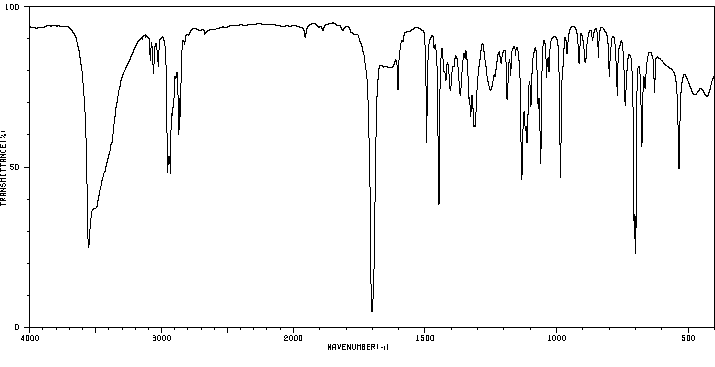2-(hydroxyphenylmethyl)cyclohexan-1-one
中文名称
——
中文别名
——
英文名称
2-(hydroxyphenylmethyl)cyclohexan-1-one
英文别名
2-(hydroxy(phenyl)methyl)cyclohexanone;2-[hydroxy(phenyl)methyl]cyclohexan-1-one
CAS
——
化学式
C13H16O2
mdl
MFCD00453441
分子量
204.269
InChiKey
YQBZNNFVXOBDSJ-UHFFFAOYSA-N
BEILSTEIN
——
EINECS
——
-
物化性质
-
计算性质
-
ADMET
-
安全信息
-
SDS
-
制备方法与用途
-
上下游信息
-
文献信息
-
表征谱图
-
同类化合物
-
相关功能分类
-
相关结构分类
计算性质
-
辛醇/水分配系数(LogP):2.4
-
重原子数:15
-
可旋转键数:2
-
环数:2.0
-
sp3杂化的碳原子比例:0.461
-
拓扑面积:37.3
-
氢给体数:1
-
氢受体数:2
上下游信息
反应信息
-
作为反应物:参考文献:名称:Vieweg; Wagner, Pharmazie, 1980, vol. 34, # 12, p. 785 - 788摘要:DOI:
-
作为产物:描述:参考文献:名称:A new and highly effective aldol synthesis摘要:DOI:10.1021/ja00465a049
文献信息
-
Reusable shuttles for exchangeable functional cargos: Reversibly assembled, magnetically powered organocatalysts for asymmetric aldol reactions作者:Carolina Mendoza、Augustin de la Croix、Paola Riente、Lluís Llorens、Javier de Mendoza、Miquel A. PericàsDOI:10.1016/j.tet.2019.130592日期:2019.10supramolecular approach has been followed to support adamantyl substituted proline organocatalysts onto the surface of magnetite nanoparticles decorated with a β-cyclodextrin motif. The resulting magnetic nanoparticles (ca. ∼10 nm diameter) were used as modular, magnetically recyclable catalysts in the asymmetric aldol reaction of aromatic aldehydes with cyclic ketones in water. The catalytic assemblies
-
Oxazoline-Substituted Prolinamide-Based Organocatalysts for the Direct Intermolecular Aldol Reaction between Cyclohexanone and Aromatic Aldehydes作者:Simon Doherty、Julian G. Knight、Amy McRae、Ross W. Harrington、William CleggDOI:10.1002/ejoc.200700922日期:2008.4Oxazoline-substituted prolinamides catalyse the direct asymmetric aldol reaction between cyclohexanone and a range of aldehydes to give excellent conversions and enantioselectivities up to 84 % under optimum conditions. Reactions were highly substrate-specific with electron-deficient aldehydes giving the highest yields and ee values. The absolute configuration of the 4-chlorobenzaldehyde-derived product
-
Highly efficient organocatalysts for the asymmetric aldol reaction作者:C. G. Jacoby、P. H. V. Vontobel、M. F. Bach、P. H. SchneiderDOI:10.1039/c7nj04424k日期:——synthetic route. The highly efficient five step methodology did not require intermediary purification and provided the compounds in high yields. The catalysts were successfully applied in the asymmetric direct aldol reaction between aromatic aldehydes and cyclic ketones in aqueous media. Aldol adducts were obtained in high yields with perfect stereoselectivities (up to >99% e.e. and >19 : 1 d.r.).
-
Enamine-Metal Lewis Acid Bifunctional Catalysis: Application to Direct Asymmetric Aldol Reaction of Ketones作者:Zhenghu Xu、Philias Daka、Ilya Budik、Hong Wang、Fu-Quan Bai、Hong-Xing ZhangDOI:10.1002/ejoc.200900678日期:2009.9Unprecedented bifunctional enamine–metal Lewis acid catalysts have been developed. In this bifunctional catalytic system, a tridentate ligand tethered with a chiral secondary amine was designed to solve the acid–base self-quenching problem leading to catalyst inactivation. This new bifunctional enamine–metal Lewis acid catalyst was found to catalyze aldol reactions of ketones efficiently in high yields
-
Reformatsky Type Reaction with New Aluminium Reagents Containing Al–Sn or Al–Pb Linkage作者:Seijiro Matsubara、Noriyuki Tsuboniwa、Yoshitomi Morizawa、Koichiro Oshima、Hitosi NozakiDOI:10.1246/bcsj.57.3242日期:1984.11the reagent prepared from n-Bu3SnLi and Et2AlCl or from SnCl2 and Et2AlCl affords enolates which react with ketone or aldehyde to give β-hydroxy carbonyl compounds in good to excellent yields. The reactions proceed similarly with the reagents which are generated from R3PbLi (R=Ph, n-Bu) and Et2AlCl. Catalysis by the added Pd(PPh3)4 complex promotes the reduction effectively and improves the yields of用由 n-Bu3SnLi 和 Et2AlCl 或由 SnCl2 和 Et2AlCl 制备的试剂处理 α-溴羰基化合物,得到烯醇化物,该烯醇化物与酮或醛反应得到 β-羟基羰基化合物,收率良好至极好。反应与由 R3PbLi (R=Ph, n-Bu) 和 Et2AlCl 生成的试剂进行类似。添加的 Pd(PPh3)4 复合物的催化作用有效地促进了还原并提高了所需加合物的产率。公开了区域选择性和立体选择性。
表征谱图
-
氢谱1HNMR
-
质谱MS
-
碳谱13CNMR
-
红外IR
-
拉曼Raman
-
峰位数据
-
峰位匹配
-
表征信息
同类化合物
(βS)-β-氨基-4-(4-羟基苯氧基)-3,5-二碘苯甲丙醇
(S,S)-邻甲苯基-DIPAMP
(S)-(-)-7'-〔4(S)-(苄基)恶唑-2-基]-7-二(3,5-二-叔丁基苯基)膦基-2,2',3,3'-四氢-1,1-螺二氢茚
(S)-盐酸沙丁胺醇
(S)-3-(叔丁基)-4-(2,6-二甲氧基苯基)-2,3-二氢苯并[d][1,3]氧磷杂环戊二烯
(S)-2,2'-双[双(3,5-三氟甲基苯基)膦基]-4,4',6,6'-四甲氧基联苯
(S)-1-[3,5-双(三氟甲基)苯基]-3-[1-(二甲基氨基)-3-甲基丁烷-2-基]硫脲
(R)富马酸托特罗定
(R)-(-)-盐酸尼古地平
(R)-(-)-4,12-双(二苯基膦基)[2.2]对环芳烷(1,5环辛二烯)铑(I)四氟硼酸盐
(R)-(+)-7-双(3,5-二叔丁基苯基)膦基7''-[((6-甲基吡啶-2-基甲基)氨基]-2,2'',3,3''-四氢-1,1''-螺双茚满
(R)-(+)-7-双(3,5-二叔丁基苯基)膦基7''-[(4-叔丁基吡啶-2-基甲基)氨基]-2,2'',3,3''-四氢-1,1''-螺双茚满
(R)-(+)-7-双(3,5-二叔丁基苯基)膦基7''-[(3-甲基吡啶-2-基甲基)氨基]-2,2'',3,3''-四氢-1,1''-螺双茚满
(R)-(+)-4,7-双(3,5-二-叔丁基苯基)膦基-7“-[(吡啶-2-基甲基)氨基]-2,2”,3,3'-四氢1,1'-螺二茚满
(R)-3-(叔丁基)-4-(2,6-二苯氧基苯基)-2,3-二氢苯并[d][1,3]氧杂磷杂环戊烯
(R)-2-[((二苯基膦基)甲基]吡咯烷
(R)-1-[3,5-双(三氟甲基)苯基]-3-[1-(二甲基氨基)-3-甲基丁烷-2-基]硫脲
(N-(4-甲氧基苯基)-N-甲基-3-(1-哌啶基)丙-2-烯酰胺)
(5-溴-2-羟基苯基)-4-氯苯甲酮
(5-溴-2-氯苯基)(4-羟基苯基)甲酮
(5-氧代-3-苯基-2,5-二氢-1,2,3,4-oxatriazol-3-鎓)
(4S,5R)-4-甲基-5-苯基-1,2,3-氧代噻唑烷-2,2-二氧化物-3-羧酸叔丁酯
(4S,4''S)-2,2''-亚环戊基双[4,5-二氢-4-(苯甲基)恶唑]
(4-溴苯基)-[2-氟-4-[6-[甲基(丙-2-烯基)氨基]己氧基]苯基]甲酮
(4-丁氧基苯甲基)三苯基溴化磷
(3aR,8aR)-(-)-4,4,8,8-四(3,5-二甲基苯基)四氢-2,2-二甲基-6-苯基-1,3-二氧戊环[4,5-e]二恶唑磷
(3aR,6aS)-5-氧代六氢环戊基[c]吡咯-2(1H)-羧酸酯
(2Z)-3-[[(4-氯苯基)氨基]-2-氰基丙烯酸乙酯
(2S,3S,5S)-5-(叔丁氧基甲酰氨基)-2-(N-5-噻唑基-甲氧羰基)氨基-1,6-二苯基-3-羟基己烷
(2S,2''S,3S,3''S)-3,3''-二叔丁基-4,4''-双(2,6-二甲氧基苯基)-2,2'',3,3''-四氢-2,2''-联苯并[d][1,3]氧杂磷杂戊环
(2S)-(-)-2-{[[[[3,5-双(氟代甲基)苯基]氨基]硫代甲基]氨基}-N-(二苯基甲基)-N,3,3-三甲基丁酰胺
(2S)-2-[[[[[((1S,2S)-2-氨基环己基]氨基]硫代甲基]氨基]-N-(二苯甲基)-N,3,3-三甲基丁酰胺
(2S)-2-[[[[[[((1R,2R)-2-氨基环己基]氨基]硫代甲基]氨基]-N-(二苯甲基)-N,3,3-三甲基丁酰胺
(2-硝基苯基)磷酸三酰胺
(2,6-二氯苯基)乙酰氯
(2,3-二甲氧基-5-甲基苯基)硼酸
(1S,2S,3S,5S)-5-叠氮基-3-(苯基甲氧基)-2-[(苯基甲氧基)甲基]环戊醇
(1S,2S,3R,5R)-2-(苄氧基)甲基-6-氧杂双环[3.1.0]己-3-醇
(1-(4-氟苯基)环丙基)甲胺盐酸盐
(1-(3-溴苯基)环丁基)甲胺盐酸盐
(1-(2-氯苯基)环丁基)甲胺盐酸盐
(1-(2-氟苯基)环丙基)甲胺盐酸盐
(1-(2,6-二氟苯基)环丙基)甲胺盐酸盐
(-)-去甲基西布曲明
龙蒿油
龙胆酸钠
龙胆酸叔丁酯
龙胆酸
龙胆紫-d6
龙胆紫







